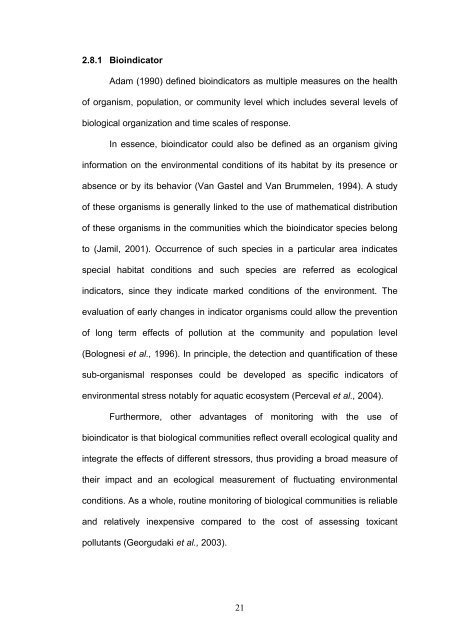IDENTIFICATION OF COPPER-INDUCIBLE GENES IN Pistia stratiotes
IDENTIFICATION OF COPPER-INDUCIBLE GENES IN Pistia stratiotes
IDENTIFICATION OF COPPER-INDUCIBLE GENES IN Pistia stratiotes
Create successful ePaper yourself
Turn your PDF publications into a flip-book with our unique Google optimized e-Paper software.
2.8.1 Bioindicator<br />
Adam (1990) defined bioindicators as multiple measures on the health<br />
of organism, population, or community level which includes several levels of<br />
biological organization and time scales of response.<br />
In essence, bioindicator could also be defined as an organism giving<br />
information on the environmental conditions of its habitat by its presence or<br />
absence or by its behavior (Van Gastel and Van Brummelen, 1994). A study<br />
of these organisms is generally linked to the use of mathematical distribution<br />
of these organisms in the communities which the bioindicator species belong<br />
to (Jamil, 2001). Occurrence of such species in a particular area indicates<br />
special habitat conditions and such species are referred as ecological<br />
indicators, since they indicate marked conditions of the environment. The<br />
evaluation of early changes in indicator organisms could allow the prevention<br />
of long term effects of pollution at the community and population level<br />
(Bolognesi et al., 1996). In principle, the detection and quantification of these<br />
sub-organismal responses could be developed as specific indicators of<br />
environmental stress notably for aquatic ecosystem (Perceval et al., 2004).<br />
Furthermore, other advantages of monitoring with the use of<br />
bioindicator is that biological communities reflect overall ecological quality and<br />
integrate the effects of different stressors, thus providing a broad measure of<br />
their impact and an ecological measurement of fluctuating environmental<br />
conditions. As a whole, routine monitoring of biological communities is reliable<br />
and relatively inexpensive compared to the cost of assessing toxicant<br />
pollutants (Georgudaki et al., 2003).<br />
21








![[Consumer Behaviour] - ePrints@USM](https://img.yumpu.com/21924816/1/184x260/consumer-behaviour-eprintsusm.jpg?quality=85)








